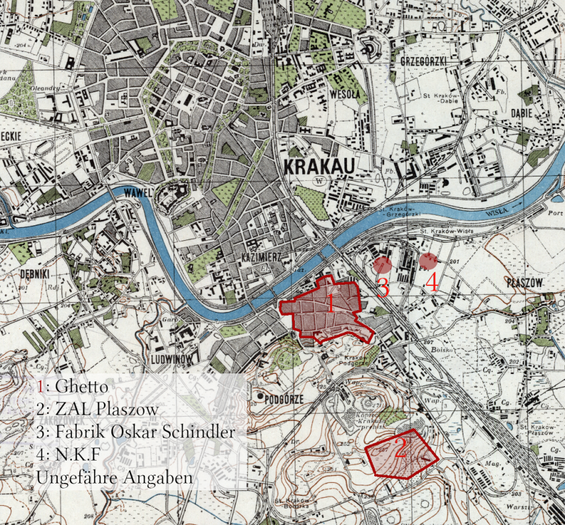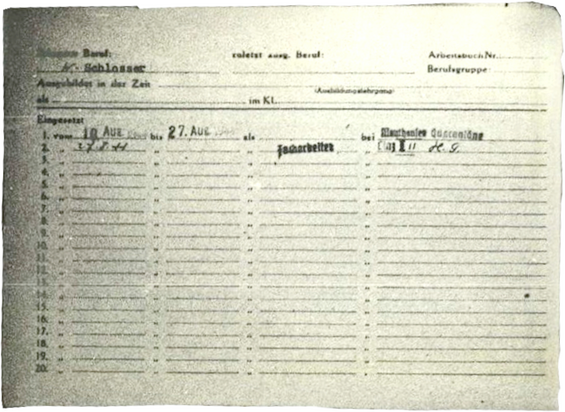The Biography of Jakob Tenenbaum, Beuthen
Short biography and stations of his persecution
Biography
- born on 20 October 1921 in Beuthen/Germany
- Krakow, December 1939 Forced labor/Jewish star
- March 1941 to December 1942 Krakow ghetto
- December 1942 to August 1944 Forced labor camp Krakow-Plaszow
- 16 August 1944 Mauthausen concentration camp, prisoner number 87178, quarantine
- 27 August to 5 May 1945 Mauthausen concentration camp/Linz subcamp III (Herman-Göring-Werke)
- Stuttgart, Mannheim
- 1947 emigration to USA
Jakob Tenenbaum lost his parents in the Holocaust. He was 18 years old when his persecution bega.
Note: from file excerpt dated 7.2.1966: "Client used false personal details in the concentration camp, namely he gave his first name as 'Hirsch' and the date of birth as 18, 19 or 20.10.1923 in Krakow. He did this to make himself look younger and thus escape extermination."
Before the War: Krakow
I am submitting this affidavit in connection with my application for compensation for damage to body and health. Before the outbreak of the persecution measures, I lived with my parents and my younger sister at Stromastrasse 9. I was a strong, healthy young man who enjoyed sports and I cannot remember ever having been seriously ill. I attended grammar school. My schooling was interrupted in 1939. My family lived in secure circumstances. My father was a second-hand goods dealer and earned enough.
Source: Unless otherwise stated: Konrad Kittl files, Jakob Tennenbaum affidavit;
Krakow ghetto
Krakow was occupied by the Nazis immediately after the outbreak of the Second World War and this marked the beginning of the persecution to which I was subjected from the outset. Even in the first few months, I suffered from degradation and was put to various forced labor tasks. In the first winter, for example, I was made to shovel snow for hours on end and we were harassed. We lived in great deprivation. When the ghetto was built, I had to move into it. I was assigned to forced labor with the NKF and had to do heavy reparation work on refrigerators. We were constantly beaten at work. Our food was miserable. We lived in constant fear of being murdered.
Note: N.K.F. (Neue Kühler- und Flugzeugteilefabriken), Kurt Hodermann, see also "Orte des Terrors, vol. 8, p. 290)
| Forced labor camps for Jews in the "Generalgouvernement" | |
|---|---|
| Place | Kraków-Plaszów (Jerozolimska Street) / Kraków-Plaszow |
| Area | General Government, Krakow District (1939-1944) |
| Opening | Beginning 1942 / 28.10.1942; women: 21.01.1943 |
| Closing | 11/01/1944 (conversion of the camp into a concentration camp under the SS-WVHA) |
| Prisons | In the summer of 1943, there were around 12,000 prisoners in the camp. |
| Gender | Men and women |
| Employment of the prisoners at | Kabelwerk Krakow; Julius Madritsch, textile company; N.K.F. (Neue Kühler- und Flugzeugteilefabriken), Kurt Hodermann |
| Type of work | Men: work in SS factories, work in the German enamelware factory, work in quarries, barrack construction, road construction; women: Work in the tailor shop, work in the SS economic enterprises, work in the German enamelware factory, work in the munitions factory, barrack construction |
| Source: deutschland-ein-denkmal.de | |
Krakau-Plaszow, Transport nach Mauthausen
I had the same work in Plaschow. At the end of 1943 I fell ill with typhus fever and received no medical help. When I once injured my right hand at work, I trembled for my life every minute, which meant that I couldn't work for a while and the sick were dragged away. As if by a miracle, I got away. I lived in these miserable conditions until the summer of 1944, when we were herded onto a train and left without food for almost two weeks. There were about 140 people crammed into one wagon.
Mauthausen, Linz
By the time we arrived in Mauthausen, more than 50% of the prisoners had died. They dragged me from Mauthausen to Linz, where I had to work as a mechanic in the Hermann Goering works. At this point I was just a wreck. I could hardly stand on my feet. My beloved father died back then. When an SS man wasn't happy with my work, he took me out and stood me against the wall to shoot me. But then he let go of me and just beat me up. I spent two weeks in the infirmary. I have little memory of the last time before my liberation, as I could hardly be described as human.
| Subcamps of the Mauthausen concentration camp | |
|---|---|
| Location | Linz III, Kleinmünchen-Ebelsberg |
| Name | |
| Area | Reichsgau Oberdonau (1938-1945) |
| Opening | 22.05.1944 |
| Closing | Liberation on 05/05/1945 |
| Deportations | |
| Prisons | 5,615 (highest number of prisoners) |
| Gender | Men |
| Employment of the prisoners at | Hermann-Göring-Werke (tank production); SS-WVHA W I Deutsche Erd- und Steinwerke GmbH Schlackenwerk Linz |
| Type of work | Work in the steel and slag works; construction of a power plant near Linz; road, air-raid shelter and railroad construction |
| Source: deutschland-ein-denkmal.de | |
After the War
I was unconscious when I was liberated and was immediately treated by US Army doctors. Later, I lived in Stuttgart and Mannheim until my emigration to the USA in December 1947. The years of persecution, the constant fear of death, the loss of my parents, the cruel mistreatment, the illnesses without medical help, the hard, unaccustomed work, the hunger, the cold and the mistreatment still affect my health today. I declare my willingness to be examined by a medical officer of the German Consulate. I confirm the accuracy of my statements with my signature on oath.
Notes
Office for Compensation
Stuttgart ES 28198 1965-1970
Notes
Further Sources
Picture Credits
- Karte: Oberkommando des Heeres / Generalstab, Quelle: Mapster, mit Angaben von Yad Vashem: "Aerial Evidence for Schindler’s List"
- RG-15.098M; Coll: City captain of the city of Krakow, 1939-1945, ID card list; Name List: Accepted Applications (#25039); United States Holocaust Memorial Museum Archives,Washington, DC
- Quelle: 1.1.26.3/1803433/ITS Digital Archive, Arolsen Archives
- Quelle: 1.1.26.3/1803433/ITS Digital Archive, Arolsen Archives



![Häftlingspersonalkarte Tennenbaum- 1, Quelle: [3]](/assets/images/v/hpk_1-1-26-3_1803433v-erzy44km6vmv8g8.jpg)
